Text
QTE: Mario Strikers in 2022??
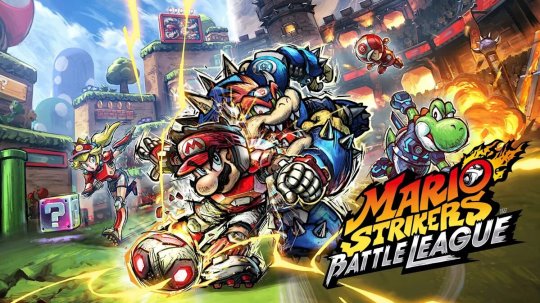
Image: Nintendo
15 years my friends!
Nintendo’s recent Direct debuting this past February 9th gave just about everyone a little something to look forward to in the coming months of the Switch’s lineup. But what no one saw coming, however, was the nonchalant, heart-stopping reveal of a long-anticipated revival after years of lost hope.
The return of the Mario Strikers series from Next Level Games is finally coming back!
For those unfamiliar with its history, this announcement may have appeared to be like any other Mario sports spinoff used to fill a gap in the coming lineup, and you may be wondering what all the excitement is about. The last of only two entries in this series was Mario Strikers Charged for the Nintendo Wii way back in the long-forgotten time of 2007. But for reasons we could only hypothesize, Strikers seemingly had the rug pulled out from it just as it was getting started, becoming just another tale for those of us who were there to tell our grandkids about.
For me, it all began in 2005 with Super Mario Strikers for the Nintendo Gamecube. I’ve always loved Nintendo’s wackier sports romps since I was young, and this game quickly swept me and my friends up like wildfire, rising to an instant classic status. There’s no shortage of fun callbacks between us—one of our friends within this group of regulars went as far as skipping track practice to meet up at my house for a few rounds. His team coach, ironically, was also one of my neighbors so news traveled fast. Strikers was like a fever, however, and I think it caught on so well for being so different—it didn’t have the same DNA to previous Mario sports games, like Mario Tennis and Mario Golf: it was frantic, intense, and dialed up the cool factor to 11.
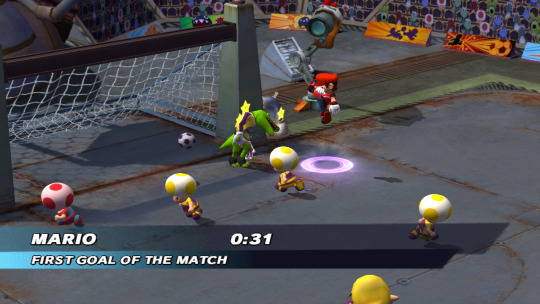
Image: Nintendo
When a sequel arrived for the Nintendo Wii in 2007, we were all over it, of course. In true sequel fashion, Mario Strikers Charged layered on several new elements to the gameplay and went even further in its brutal theme with the cast now wearing full-body armor and kicking around a metal soccer ball that could be charged up for more power—hence, the title. As a Wii game, it also included online multiplayer as well as the obligatory motion controls that included a new pointer-based minigame that put you in control of your goalie to block a six-scoring onslaught.
We could easily assume that Next Level Games, the developer behind this beloved soccer spinoff and recently acquired by Nintendo in 2021, had their hands full in reviving Luigi’s Mansion with two sequels—Luigi’s Mansion: Dark Moon for 3DS in 2013 and Luigi’s Mansion 3 in 2019 for Switch. Preceding Luigi’s return to ghost hunting, the studio released several other games following Charged, including another revival—this time it was the return of Little Mac in Punch-Out!! for the Wii.
While Next Level Games has clearly been busy all this time, it’s also been speculated that Mario Strikers, in its drastic departure from what you would expect to see in a typical Mario game, inevitably reached a breaking point post-Charged. Mario Strikers are violent games. Though never beyond cartoonish, characters throw their whole body into tackles that can make you wince, and the playing fields are surrounded by electric fences for some reason? And of course, who could forget the amazing victory animations, such as Waluigi’s unforgettable crotch chop celebration.

Image: Nintendo
However, though for years it seemed like a Strikers revival was a distant hope, something has happened behind the curtains and Nintendo finally delivered. With the recent confirmation that Next Level Games is indeed the developer for Mario Strikers Battle League, I’ll be eagerly waiting alongside fans and newcomers alike to the new era of Strikers.
And I hope that this time next year, we’ll be talking about Mario’s return to baseball…
#mario strikers#nintendo#next level games#nintendo switch#video games#mario strikers battle league#qte
6 notes
·
View notes
Text
Cooldown: Not Just a Bunch of Numskulls!
Note: This post covers some of the major details of Pokemon Sun and Moon’s plot.
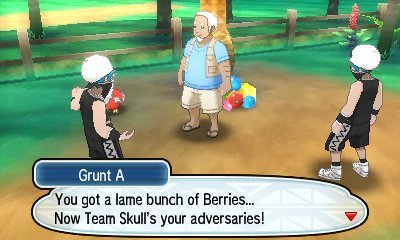
Image: serebii.net
Personally, if there’s one thing about Pokémon that has captivated me throughout the years, it’s those shadier elements that have snuck their way into each generation that twist the otherwise saccharine image of GAME FREAK’S beloved JRPG.
One recurring shape we often see this take form is of a nefarious organization working behind the scenes while a fresh-faced Pokémon Trainer, leaving home for the first time, aspires to climb the top of the Pokémon league with the aid of their very first Pokémon and loyal friend. The classic example would have to be Team Rocket, first appearing in Pokemon Red and Pokemon Blue all the way back in 1998 (’96 for Japan where it was Red and Green). Team Rocket was a tonal whiplash to a world of catching and battling Pokémon; they operated like a gang of thieves stealing Pokémon from Trainers or even plucking them out of the wild.
It was a total disruption to everything we learn early on about the balance between Pokémon and humans.
While we’re told both coexist peacefully and have formed life-long friendships in some cases, that innocence is challenged by a group that has gone as far as gruesomely removing the tails of Slowpoke to sell for profit.
Pokémon recently celebrated its 25th anniversary last year, and in that time, we’ve seen numerous shady characters and organized forces, spanning multiple generations of games, each with their own methods of opposing the otherwise colorful and charming world inhabited by our favorite pocket monsters. Team Rocket, specifically, has appeared multiple times, and if you count the animation, they hold the longest-running grudge making them the most successful—depending on what you’d call success, that is.
Now, I’ve said in a previous post that I’m in no way the biggest Pokémon fan; I first ran out of steam after Pokémon Diamond back in 2006. However, in 2016, I took a chance on the 3DS release of Pokémon Sun and Pokémon Moon—I scored a copy of Sun while a good friend of mine grabbed Moon. After a long break, this generation took me by surprise, and I ended up enjoying it as a whole quite a bit. I liked many of the new Pokémon and thought the shift from traditional gyms to island challenges was a neat change of pace, and so far, narratively speaking, it’s my favorite in the series.
And buried right in the middle of that narrative is the thing that I recall first anytime I think about Pokémon Sun and Moon—the introduction of Pokémon’s greatest team of villains to date: Team Skull.
If you’ve played either Sun or Moon, you might be nodding your head in agreement or demanding an explanation right now. I wouldn’t disagree that Team Skull are probably the least effective villains in Pokémon—if you can even call them that—to the point of being nuisances more than a devious operation like Team Rocket.
So, why in the world would I award them a bold title like that?
Because I would argue that Team Skull, underneath their tough exterior and corny dialog, brought something memorable to the table as a vulnerable group led by flawed, yet human, leaders whose actions cause them to be exploited by the true evil hiding in plain sight within the Alola region.
DEEP TO THE BONE

Image: serebii.net
We’ve seen real threats to both people and Pokémon since the lime-green pixel days of Red and Blue. But in a world that’s survived global domination and was almost wiped away by catastrophic flooding, nothing has been as compelling as two low-ranking grunts attempting to steal a bus stop sign. While Pokémon Sun and Moon does indeed hide a greater evil for a later twist, we’re initially confronted by something with less bite and more bark.
Nearly halfway through the expedition of Melemele Island in Sun and Moon’s early hours, the player meets Trial Captain Llima, while visiting the Alola Trainer’s School, when two troublemakers approach the group to stir up trouble. Revealing themselves as Team Skull, they loudly barge in with wild hand signs and one-too-many bone puns in an attempt to shake our group up with fear, while the accompanying theme playing in the background shouts “we mean business.”
But, in what becomes a running gag for these lowly grunts, their momentum is immediately shut down as Llima turns to ignore them and continues their conversation with the player.
This encounter, and others like it, paint Team Skull as the comical relief and are nothing like the opposition of the past because of it. Their threat level is remarkably smaller compared to the likes of Team Rocket or Team Galactic, coming across as bullies rather than anything close to organized. But their effectiveness is questionable when even most Alolans appear annoyed more than anything you could call intimidation. And it’s not hard to feel that way—while Sun and Moon’s quirky ne’er-do-wells hold nothing back, their persistent goofy puns and aggressive posturing are constantly brushed off.
However, Team Skull gradually sets itself apart from the past opposition by evolving like any other Pokémon found throughout Sun and Moon. Those initial tangles with various grunts depict them as simple street toughs, but somewhere along the journey across Alola’s four islands, that façade is dropped, and it becomes clear that underneath there’s a vulnerable side trying to hide itself. It starts with bits of dialog that sneak in alluding to things like self-esteem issues—they are just kids after all—before finally reaching the tipping point on Ula’ula Island.
And standing atop that climax, we get to know the real Team Skull, the one that survives within a run-down, abandoned Po Town that lacks even basic needs like electricity, among other things.
While Po Town’s fate is owed to Team Skull, who originally ran everyone else out, the player discovers it’s been essentially cut off from the rest of Alola. Windows are broken, graffiti is scrawled on just about every surface, and shelter is rationed off and shared by many. As foreboding as the gate blockading the town is, the inside reveals a harsher reality of kids huddling together for survival.
Most effective is during a moment upon entering the local Pokémon Center and discovering it only offers its services at a fee—not because it’s an underhanded way to steal money from the player, but because, as the grunt behind the counter somberly rhymes out the truth, it’ll keep the lights on.
FLAWED LEADERS WITH A BACKBONE

Image: serebii.net
And where are Team Skull’s leaders during this?
Both Plumeria, Team Skull’s Admin, and Guzma, the hot-headed head honcho, are what you could call the cherry on top.
After several encounters with some persistent grunts, Plumeria suddenly reveals herself to the player, confronting them like a protective, older sister. She acknowledges their shortcomings, but she establishes that there’s a sense of family within Team Skull, and is an attitude we see consistently from her throughout Sun and Moon. While Guzma arrives fashionably late to the party, his first move is to challenge Professor Kukui, where we learn of a past that’s only built up to frustration that leads back to the Alola region’s island challenges that the player is currently endeavored on.
Both Plumeria and Guzma ultimately make the same fatal mistake in trusting the wrong people.

Image: serebii.net
During the final act of Sun and Moon, it’s revealed that President Lusamine of the Aether Foundation is the true villain lurking in Alola while also pulling Team Skull’s strings. While they agreed to the dirty work, it becomes clear when the real Aether Foundation surfaces that they’ve become a victim just as much as everyone else in Alola. Guzma’s troubled past and need to be recognized as an accomplished Pokémon Trainer allowed Lusamine to fuel his ego. and it nearly destroys his own team in the process.
Following the conclusion of Sun and Moon, several of Team Skull’s members adapt to a new life—some even form a rescue team to help Pokémon in need. Meanwhile, Guzma is taken in by Kahuna Hala as a protégé to help him take the chip off his shoulder so he can become the Trainer he really wants to be
In the end, Team Skull is kind of a mess. Their presence arguably doesn’t hold the same weight as Giovanni’s Team Rocket if we’re talking about ambitions. While Guzma was standing by Lusamine’s side nearly to the end, it was never at an eye-to-eye level. Team Skull was played from the beginning and almost walked away with nothing.
But this is a team that stands out for its weaknesses rather than its strengths. Instead of cold and calculating like their hidden benefactor, the Aether Foundation, Team Skull is comprised of real people with real issues that the true evil sought out to exploit.

Image: serebii.net
27 notes
·
View notes
Text
Apologies again for this week! I have a piece in the works about Pokémon Sun and Moon, specifically about Team Skull that ended up needing more time so I could put together more research. That one will be up next Wednesday instead. I was also working on a shorter piece about Mortal Kombat Armageddon to make up for the absence, but some life stuff got in the way that I had to prioritize first.
I hate to leave this space empty handed for the week, but both of these will be something I can be proud of with the proper time. Like last week, I’ll try to get a couple of shorter pieces out between today and next Wednesday.
- Justin
1 note
·
View note
Text
QTE: Legend in the Making?

(The Pokémon Company/GAME FREAK Inc.)
So I guess you could say the hottest Pokémon topic right now is the release of Pokémon Legends: Arceus, and what it could mean for the franchise going forward?
I’ll start by saying that I don’t really have a large stake in the progressions and outcomes of Pokémon, but I’ve been something of an interested observer since a childhood visit to the dentist, where a Game Boy Color and copy of Pokémon Blue Version occupied the waiting room so I could drown out the sounds of teeth drilling momentarily.
Pokémon Gold Version was my first full experience, however—this time without the dental work. I like to think it arrived at the right time for me, and before long I was hooked like every other kid I knew in school. I would go to a local mall for card sales with my dad, to fill a binder he loaned me from his baseball card collecting days, and I repaid him like any other good son by dragging him and my sister to Pokémon: The First Movie. I can also fondly remember catching an episode here and there of the animated series, while visiting my grandparents, on one of their old wood-paneled TV sets.
Though Pokémon stayed with me through the eras, it always ran parallel to others like Super Mario and The Legend of Zelda, reigniting in certain instances like the updated release of Gold and Silver with Pokémon HeartGold and Pokémon SoulSilver. When the steam cleared, however, Pokemon had finally lost its grip on me, and it wasn’t until Pokémon Sun that I attempted to rekindle the spark, unsuccessfully.
While those memories of Gold were fun to relive, the formula had become too predictable for my tastes. I never grew tired of the idea of strengthening a character or party, however, and eventually sought that out in other forms both RPG and JRPG. Now, I think the grinding aspect of Pokémon has merit—Dragon Quest has for decades thrived on this formula with no signs of slowing down, and as a recent fan, I don’t think it’s necessarily the experience grinds that wear people like me out.
Rather, it’s the motive to the journey, which is something that has changed very little for Pokémon since the beginning.
You’re the next in line to become a Pokémon Trainer, gathering a powerful team and maybe even climbing the ranks all the way to the Pokémon League. And you’ll probably find time to stop those meddling adults that can’t just let the world of Pokémon be. It’s all very familiar at this point, and while it’s a solid foundation to build a team of old and new to compete with friends, we know by now that Pokémon is filled with all sorts of interesting things that we’re never able to interact with, aside from spinoffs.
So, I look at Pokémon Legends: Arceus as a sign that fans and developers may finally be aligning. Here’s a Pokémon game that gives you a world to interact with as you choose. Track them, catch them, avoid them, research them. You’re not a trainer, you’re an explorer, something already very real to the franchise but never trusted to us before—except behind a camera.
I’m choosing to believe Arceus has a future and the response from critics and fans so far gives cause to think so. I can only hope that both GAME FREAK and The Pokémon Company are emboldened to expand Pokémon’s formula further.
7 notes
·
View notes
Text
Just a heads up for this week, I wasn’t able to get a regular post ready in time because I was fighting off a cold over the weekend, but I’ve got something going up today in its place. And I’d like to try to post a couple more between today and next Wednesday. Meanwhile, I’ll be back on track next Wednesday with my regular post.
- Justin
0 notes
Text
Cooldown: Trying to Survive in the Background of a Fighting Game
Note: I’ll be discussing story details of Tekken 7 in here, but not the larger stuff. It’s a fighting game so maybe it’s silly to write a warning for this, but fair is fair.
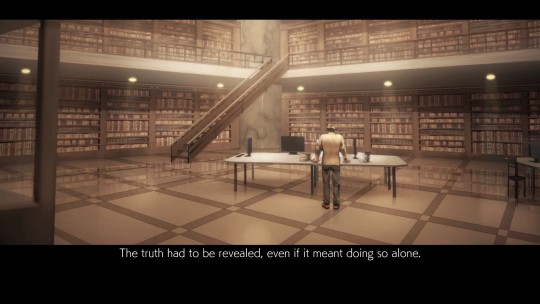
“He was also the one who started this damn war, which took everything from me.” -The Journalist, Tekken 7
Very recently, I was inspired to consider a world of champion fighters where everything hinges on who wins or loses—where everyone else just making a living may not even be aware of the actions of an unseen force, until the consequences come crashing through like an unstoppable life-changing tidal wave.
Traditionally, the narrative surrounding fighting games, including the colorful motivations and agendas, were largely self-contained to the playable roster. Every action each fighter took, everything they fought for, and every consequence to their actions, was largely reserved to those gracing the character select screen.
2009’s Mortal Kombat, from developer Netherrealm, is considered a pivotal moment in fighting game storytelling by allowing its world-saving tournament concept to surface with cinematic cutscenes that add weight to the character’s motivations and the overall lore. Mortal Kombat is not alone, of course, as others such as Soul Calibur, Killer Instinct, The King of Fighters, and Street Fighter, all similarly pack their rosters and settings with memorable characters that, for one reason or another, were brought together into a fight for their lives. That kind of strength in personality is what immediately drew me into Tekken and its cast, as well, when I rediscovered it late last year.
However, returning to Mortal Kombat for just a moment, even in a world where the outcome is potentially an apocalyptic invasion of Earthrealm by Outworld’s ruler, Shao Khan, we really only ever see this nightmare scenario through the eyes of the main characters. Anybody else present is basically background fodder and isn’t given the opportunity to standout, nor are we given much reason to consider the effects that the catastrophe suddenly dropping into their laps would pose.
Granted, most people don’t come to fighting games for this kind of thing—we’re obviously more invested in the people we get to play as. But I recently encountered a character within Tekken 7, the current iteration in the franchise, that challenged that perspective. A humble, relatable character that exists to absorb the madness created by others he’s never met, and is forced to somehow make sense of it all.
Tekken first appeared within the arcade scene of 1994 and has since fostered a recurring appearance on Sony’s PlayStation line, as well, until going multiplatform with Tekken 6 in 2009—after first launching to arcades in 2007. Developed by Bandai Namco Studios, and overseen by series producer, Katsuhiro Harada, Tekken was not totally unlike the others in the fighting space before its sixth entry—narratively speaking, that is. Characters both good and evil inevitably collide due to the machinations of the Big Bad pulling the strings. In this case, the fuel igniting the fire was father and son, Heihachi Mishima and Kazuya Mishima, respectively, whose ongoing feud and shifting power struggle draws spectators in like moths to a flame through the recurring King of Iron Fist Tournament hosted by none other than the Mishima Zaibatsu.
The events leading up to Tekken 6, both big and small, were quickly accelerated, however, when the war between the Mishimas suddenly became the entire world’s problem.
Enter Tekken 7 and the Journalist.
EYES AND EARS
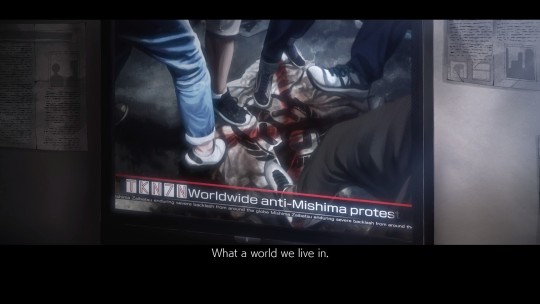
“The atrociousness of the fighting was inconceivable to the average person.” -The Journalist, Tekken 7
The Journalist in Tekken 7 serves as a common storytelling tool that has been deployed throughout narrative fiction for decades, from movies to novels and more. As the narrator, he’s the audience’s advocator—speaking for them, absorbing the rules set by a fabricated world, and grounding us as much as possible. While he’s never named and his face remains mostly obscured, he’s ultimately and unwillingly plunged into the thick of the plot after his life is ripped away by the surrounding chaos.
The events of Tekken 6 saw the two major powers of the Mishima Zaibatsu, under the leadership of Jin Kazama, and the G Corporation, where Jin’s father, Kazuya Mishima, puppets the organization from the shadows, come to a global-scale conflict that essentially drags the entire world into war. Without going too deep into the chronology of Tekken’s history, the three-way struggle within the Mishima family has served as the backbone to the major events of each entry, while most of the supporting characters within the playable roster are involved in some way—as a rival, an ally, an enemy, or an opportunist.
And in the case of a few characters, such as the unnamed Journalist, a victim of the violence.
Tekken 7’s story mode runs on two parallel paths where the player directly participates in the life-or-death fight between the Mishimas, and as an unplayable observer searching through the mysteries dug up by the Journalist. He himself has lost a great deal up to this point, and shares his tragic backstory in the game’s opening cinematic. After a tour working as a reporter covering the war, he returns home to find nothing left but fire and ash where his hometown once existed. Life, including those of his wife and son, have been viciously burned away.
And with that, the once-isolated arena in a fighting game now infiltrates into the “real world”, as it were, in the form of an average Joe trying to survive in the background.
As the story develops, the Journalist’s research inevitably causes him to cross paths with the core cast, and it’s here the absurdity of the Tekken lore knocks the wind out of him. Family feuds, corporate takeovers, volcanoes, devils—being asked to comprehend these whys and hows becomes a tall order for someone previously completely in the dark.
RIPPLE EFFECT
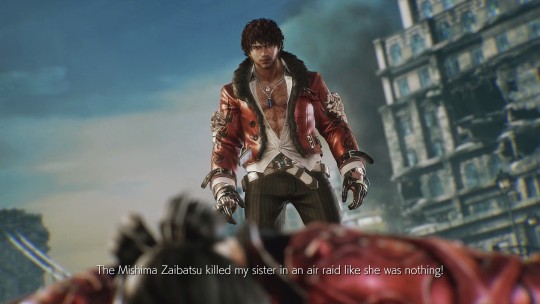
“The man who had stolen everything from me lay before my eyes.” -The Journalist, Tekken 7
The escalation to a global conflict naturally led to similar tragic stories that simultaneously fueled motivations for revenge, justice, and even resistance.
In Tekken’s lengthy history, some characters lie at the heart of the conflict, others are seeking the glory as King of the Iron Fist Tournament, and a few have personal agendas known only to them. But both Tekken 6 and Tekken 7 introduced playable fighters that were directly motivated from the devastation created by both the Mishima Zaibatsu and G Corporation.
Some lost friends or family, while others were driven to return the favor.
As one of Tekken 6’s new characters, Miguel Caballero Rojo held his dying sister in his arms after a massive bombing attack ordered by the Zaibatsu annihilated his hometown. Tekken 7 similarly introduced survivors with heavy losses and compelling reasons to confront the source of that pain. Shaheen, formerly serving in the military and now working with a private military firm, lost his friend to a hostile takeover by the G Corporation after he was suddenly found dead—which was ruled as an accident—and suspected Kazuya Mishima to be the mastermind of that mysterious death.

Leroy Smith, a Wing Chun master and survivor of New York City gang violence, returns after decades of studying martial arts to confront the man he holds responsible for it all, Heihachi Mishima. And finally, Lidia Sobieska, Prime Minister of Poland and leader in a revolt against the Zaibatsu’s illegal encroaching into her homeland’s territory. As for the Journalist, his ambitions to expose both father and son’s history eventually brings him face to face with both Jin Kazama, in a moment where he nearly takes Jin’s life as he recovers, and Heihachi himself who answers every question the Journalist sought out only on the condition that he tell the rest of the world.
And while Tekken 7’s story concludes, the hostilities are far from over, but the Journalist achieves his goal nonetheless to expose the chaos he now lives in with the only weapon he could fight with, pen and paper. Though you can’t choose him on the character select screen, the Journalist is a part of Tekken now, unwilling or not.
“That day, my old life ended, and a new one began…” -The Journalist, Tekken 7
Source: https://tekken.fandom.com/wiki/Tekken_7 (For character details on Leroy and Lidia)
6 notes
·
View notes
Text
Cooldown: Steel the Best Map in Team Fortress 2
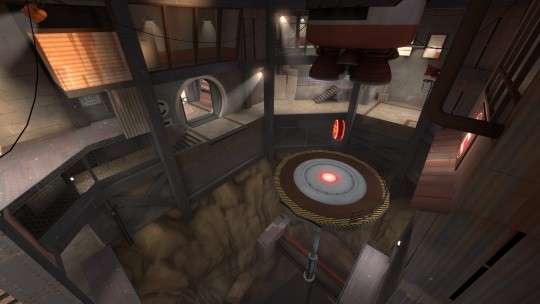
Possibly one of the finest online multiplayer shooters, and easily one of my most favorite games, Team Fortress 2, will turn 15 years old this year in October.
Launching on October 10th, in a well-known packaged deal from Valve called The Orange Box, it was the game that stole hours and hours of people’s time away—people like me—and remained massively popular for several years. Speaking personally, I was a little late to the launch—I bought a separate edition for $20, in a Walmart I believe, back in the Summer of ’08, which is still one of the best video game purchases I’ve ever made. I was on the edge of graduating high school then, and it consumed most of my free time in those handful of months—not only as a game I enjoyed, but as a first-time online multiplayer experience that even led to friendships I maintain today.
While most shooters today have incorporated a “hero” system, making each character identifiable by their special abilities, TF2 operates in a now antiquated class-based system, meaning each of the nine classes stands out by the weapons they carry into battle, rather than activating special skills—although there are a few that have a passive characteristic, like the Scout who can double jump.
When it launched in 2007, the original rotation of maps developed by Valve consisted of Gravelpit, Dustbowl, Granary, Well, 2Fort, and Hydro; altogether, these maps were spread across four distinct game modes. While it was somewhat of a humble launch, one of TF2’s greatest strengths that developed over the years was the continuous free updates that added new major content to the game in the form of additional maps, weapons, and game modes. By late 2009, these updates had completely overwhelmed its original identity, and it wasn’t uncommon to see all of my friends on Steam playing it at the same time as a new update landed during the peak of its popularity.
One of the early defining moments in TF2’s update history was during its second class update on June 19th, 2008 for the Pyro, where Valve adopted two community-made maps into their official rotation: Fastlane and Turbine, authored by Arttu “skdr” Mäki and Bill Johnston, respectively. Both seamlessly filled the mold created by Valve, and their creators were even paid for their work, something that became a trend through TF2′s lifespan.
In the subsequent update, The Heavy Update of August 19th, 2008, Valve included two more maps—one of their own called Badwater Basin and another community map by Jamie “Fishbus” Manson called Steel. Because this was the first update I had the opportunity to participate in, it’s an especially memorable one. These updates always promised a chaotic two weeks’ worth of fun as everyone packed into the servers to experiment with the new weapons and explore unfamiliar maps. This particular update was no exception, and it introduced what became something of a controversial map to some, while also one of my all-time favorites.

Source: https://www.teamfortress.com/heavy/cp_steel.htm
The truth is, Steel’s acceptance into Valve’s ensemble made it a bit of an odd duck in its day compared to the rest of the rotation. It was truly an experimental design and bent the rules of Attack/Defense, one of the handful of stock modes, where the BLU team attacks RED’s defense and attempts to capture all control points to win. However, I always felt it came at the right time, and I would argue it wasn’t a coincidence that it shipped alongside Valve’s equally experimental Badwater Basin.
You can probably guess by now I have an agenda here, and you would be correct. And I’m hoping I’ll have sold you on the idea that Steel is one of Team Fortress 2’s most rewarding maps by the end of my rambling. I guarantee it—you won’t find this kind of freedom in exploration that enables all nine classes to excel in their strengths on any other map.
CHOOSE YOUR OWN PATH
Attack/Defense up to the point of Steel’s official adoption was largely straightforward, and probably what made it one TF2′s more popular game modes. Generally speaking, BLU’s task is to penetrate RED’s defenses and claim the required capture points to win the round. Both Dustbowl and Hydro are divided into a series of stages, while Gravelpit is a single stage containing three capture points.
Hydro is an entirely different beast, a master of its own game mode, if you will, called Territory Control. But, other than a unique spin on the formula that plays out like a tug-of-war, it’s still a battle between BLU and RED over control points.
Steel, however, goes further by turning the mode on its side in a stark contrast to other maps, like Dustbowl that functions as a linear war, giving the BLU team the opportunity to strategize an approach that isn’t possible elsewhere. This is made clear at the initial splash screen detailing Steel’s structure and the characteristics of its control points—unlike other maps, each control point functions as part of a network that leads back to the final point. In total, the RED team holds territory amounting to five control points labeled A through E. In a twist, however, the final point is unlocked at the start of the round, meaning BLU can ignore the rest and claim the round quickly.

Sounds easy enough, but Steel has its tricks, and shifts in balance only if BLU works together to flip the scales on RED.
The remaining capture points, A-D, not only add more time to the round, but grant additional pathways to BLU that ease capturing the final point, as well as slightly hindering RED in the process. For example, at the beginning of the round, the final point sits atop an island platform, making it that much harder to access it. Capture point C, however, and three bridges will extend to the platform so that all nine classes can easily reach it, causing RED to reconsider leaving E wide open.
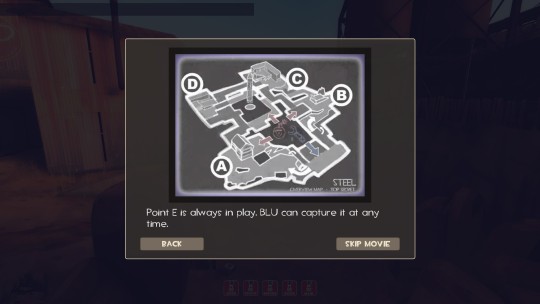
Traits like these are found all over Steel, which means it’s admittedly much more complex than other maps found in Team Fortress 2, making it something very unfamiliar back in 2008. Like Valve’s own Hydro, it was a map that stuck out in comparison to TF2’s pick-up-and-play nature where other maps offered faster, more direct gameplay. I personally think one of Steel’s greatest strengths—an open design that rewards exploration and trying new strategies—is also one of its biggest drawbacks for most players that turned it down. Steel can be very confusing when you first try it since there’s no truly linear route—you can choose to capture the points in order, but there’s no shortage of paths to get to each one, meaning a newer player has plenty of opportunity to become lost.
But I’ve always felt those design choices were worth the risk, and that Steel was a map everyone should try at least once. It’s a design that maximizes the possibilities of Attack/Defense and compliments TF2’s replayability by offering something slightly different each time.
Now, I can praise Steel for that alone, but it’s everything above that makes the following much more significant—the classes.
PICK A CLASS, ANY CLASS
For those unaware of Team Fortress 2—which makes me feel old to even say that—a variety of weapons are spread among the nine classes each with their own characteristics, such as movement speed and health pools. Without going into too much detail on each one, there’s the Scout, Soldier, and Pyro who thrive on offense; the Demoman, Heavy, and Engineer providing the backbone of defense; and finally, the always valuable support classes consisting of Medic, Sniper, and Spy.
Each class functions like a two-way street in TF2—the things they bring to the table can greatly benefit their teams depending on the map and game mode, while a map’s design must strike a balance in order for each class to do what they do best.
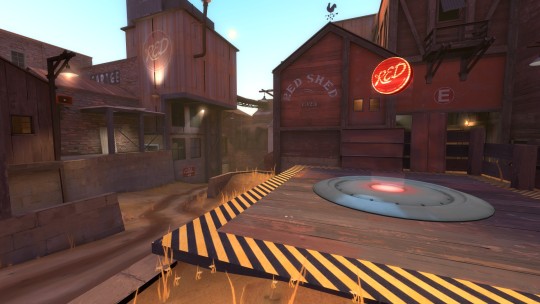
For example, the Scout runs at a speed no one else can match and is the only one who can double jump, meaning a map can’t rely too much on chokepoints and should give Scout players interesting shortcuts that other classes can’t access. Both the Soldier and Demoman are capable of making huge leaps using their own weapons and excel at fighting on heights. Pyro and Heavy similarly find greater success when they close the gap before being discovered, which is especially true for the Spy who needs side routes to sneak across the lines and reappear undetected, ready to strike. It’s a balance that I don’t envy past and current mapmakers having to make, both within Valve and the community—though I tried a couple of times myself.
But Steel nails it right out of the gate as the round begins.
The initial area is not unlike Valvel’s Badwater, with a similar hearty helping of options to both attack and defend from. BLU’s spawn in Steel, for example, diverts into two paths, one path leading to A while the other leads to B. The area surrounding A itself is like a playground; a wide, winding path for Scouts to zip through, a high-rising cliff for Soldiers to jump over or Demomen to lob their arcing grenades, and a walled-off perch for Snipers to survey the land for prime targets.
You’ll find similar playgrounds throughout Steel in capture zones that appear characteristically distinct. As was described previously, this is coupled by the fact that each capture point acts like a bonus for BLU’s efforts, changing the environment slightly each time, and eventually culminating into total chaos for RED if there isn’t a greater effort to push back their advances.

Team Fortress 2 was, for some time, frequently updated by a small team until it finally wound down as Valve moved onto newer projects. In that prime time of development, though, the many systems and mechanics evolved, including all nine classes. New weapons could sometimes morph a class into something unique from its original conception, such as the update that added a sword to the Demoman’s arsenal, making him a dangerous threat up close—unlike before with a kit of indirect weapons.
Each class update, as well as others, redefined the meta within TF2 almost every time, and this outwardly affected the gameplay in several maps and game modes. Some maps gradually showed their age, having never accounted for some of the classes’ new characteristics, such as the Engineer’s current ability to pick up and carry his buildings.
Because of this, what Steel was then may not be what Steel is today, something I haven’t had the opportunity to explore unfortunately. But I can say that maps like Steel were the best of Team Fortress 2, and that it came at the right moment while Valve was experimenting with fun ideas for their then massively popular shooter set in a wacky theme dripping of 1960s Spy Fiction that claims Abraham Lincoln both invented stairs and died while attempting to rocket jump over them.
While there’s no shortage of things I can praise TF2 for, today I’m making a case for a small piece of its history that has since been overshadowed.
And it is absolutely steel the best map in Team Fortress 2.
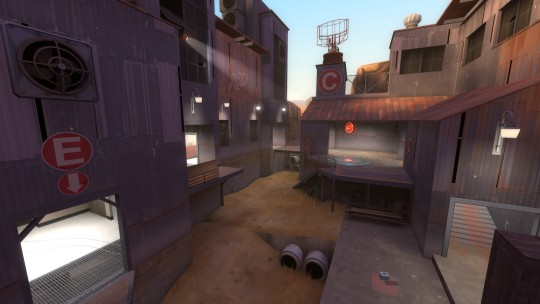
9 notes
·
View notes
Text
Cooldown: Why I Collect Video Games
After a couple of years spent collecting video games, I’ve learned that there’s more to it than just existing as a personal nostalgia vault.
I technically started collecting as a young kid who held onto every console and game he received as gifts, starting with a Game Boy and Super Mario Land. The first console I had at home was an N64, while my grandparents were my and my sister’s sole access to an NES. Meanwhile, my dad kept an SNES stored away just for us every time we visited him. In time, I eventually acquired both and are still with me today, including the same games we all enjoyed on each. The wild west of PC gaming wasn’t something I really explored until the late 2000’s, but many afternoons were spent with my sister playing The Sims and Zoo Tycoon, to name a few, on a cozy Windows XP desktop—a few of those CD ROMS are resting comfortably on a shelf presently.
But for a long time, my game collection consisted only of those generous gifts and relics of past good times. The farthest casual hunt back I can think of was many years ago when my sister and I took a chance on a humble shop in the middle of nowhere, almost too close to a railroad track, and managed to grab copies of both Luigi’s Mansion and Metroid Prime for the GameCube.
In 2020, however, I finally dove into the deep end of collecting online via eBay.
That turned out to be an interesting adventure, learning new terms like “cib” or complete in box, and having to tread cautiously in fear of sketchy listings and potential fakes. I learned of websites such as pricecharting.net that acted like a beacon in a storm to assure I was getting a decent deal in a time where used game prices were chaotically spiking throughout 2020. Because of the volatile nature of the market in that period, my initial collection fever was directed towards Sony’s PlayStation 2, where used prices had generally remained stable—in most cases fairly low. My PS2 library at the time consisted of only a small smattering of games my stepdad had purchased alongside it years ago, but grew three times larger by 2021.
I haven’t taken a count recently, but for some perspective, there is currently a shelf waiting patiently inside its box for me to assemble it so that my other shelf—currently overflowing, just a bit—can breathe a little better.
Quantity, however, hasn’t been my sole purpose for collecting.
It initially started with the hunt for games that had gone missing, then developed into the games I missed out on—lack of the right console, didn’t care for the genre at the time, you name it. That gradually sparked a new motivation—I knew I wasn’t alone in missing out on this hobby’s best of the best. Gaming is an expensive hobby, unfortunately, and it’s not hard to miss out on an entire generation because of it. Today is no different; the demand for the PlayStation 5 and the Xbox Series X to the crippling shortages that are hindering PC builders means many are staring at a wall they can’t climb. And if you can’t find something in store, you’re considering paying double online, and that’s before investing in games.
For this reason and a few others, I began to feel that if I was going to build a collection, that it wasn’t going to be just for myself. I wanted it to be for the benefit of friends, family, and the larger community surrounding video games. That desire took on a few different shapes I’d like to share as my reasons for collecting video games.
DISCOVERY: NEW FAVORITES AND SHARED FUN
If there’s one thing I’ve enjoyed most about collecting video games over the past two years, it’s been sitting down with each one to try something new.
In the past, I skipped games and entire genres—sometimes by choice sometimes not. Collecting became an opportunity to see how much my tastes had changed. My 2021 GOTY list is almost entirely made up of games I wouldn’t have taken a chance on before, or otherwise slipped under my radar. While I enjoyed discovering and playing these games, I similarly gained an appreciation for the devoted communities surrounding each one.
Venturing into the right corners of the internet would lead to fanbases springing up around gameplay, soundtracks, characters, artwork, fan fiction, and so on. In some cases, I became a fan myself and was inspired to help spread the fire among my friends.
A very good friend of mine can testify to me hauling my consoles over to his house multiple times to share my latest pickups and fascinations. One fond example was for a gauntlet of fighting games. It was especially fun whenever we revisited the past to remember why we liked a particular game or franchise so much. I lost count of how many rounds we went at it over both Soul Calibur II and Tekken 6 before the sun fell, but moments like that have been powerful motivators to keep a collection and take it as far as it can go.
I mentioned my GOTY list, and that’s really only the tip of the iceberg for the opportunities I’ve had so far. It’s amazing the wealth of experiences there are out there in gaming—you can surprise yourself almost regularly. Within the past two years I’ve become a fan of Persona, Yakuza, Earth Defense Force, Ace Attorney, Devil May Cry, Tony Hawk’s Pro Skater, and Tekken, to name a handful of franchises. For genres, I’ve warmed to things previously outside of my wheelhouse such as walking simulators and visual novels.
That’s the beauty of gaming, I think. Collecting isn’t limited to displaying trophies. You can lift the glass and find stuff you want to return to, and tell everyone you know how cool it is.
PRESERVATION: BRIDGING OLD AND NEW
Amassing a collection eventually grew to amassing knowledge of both video game history and culture.
Beyond playing games, I’ve religiously—going back to grade school—kept up with industry news, picked up bits and pieces of history, and tried to remember as many names as I could. I was absolutely the kid in school who could give you release dates on demand. That’s never really gone away as I’ve reached 30, and only expanded to reading various books on the subject—contemporary, non-fiction, manga, it’s all there. I obviously like to write about games, but I also like discussing them at length, including the culture surrounding them. I have amassed a huge soundtrack collection—an ongoing project—that I’m listening to now as I write this. I follow YouTube channels that offer a unique perspective from my own.
What I’m saying here is I am a really huge nerd—be warned.
So, it was inevitable that collecting games was going to meld into this history somehow; it has and it took on a few different shapes. I’m one of those people who wishes to not only increase access to games but attempt to preserve previous generations. I collect physical copies where possible, I maintain my consoles that run those games, and generally aspire to offer things the way they were.
I’m not, however, unaware of the various difficulties from disc rot to failing hardware. It’s a sad reality but is why I grew to admire the efforts of those preserving games via emulation. My wish is that in time both methods will remain possible and reliable.
One of the other side of the coin, there’s my subjective agenda to keep the spirit of old game design on the surface. I could go to lengths on this subject—I’ll spare you—but in short, there’s something to be said about going back to older video games that you can just pick up and play. In recent times, an aggressive momentum from certain publishers has muddied the waters on video game design, where fun comes after you���ve downloaded patches, purchased dlc, grinded battle passes, and stored your credit card for in-game purchases.
That might sound bitter, but I write that as someone who grew up with games as a source of entertainment, sometimes as an escape, but not as a product.
Building a collection of the weirdest of the weird, the sleeper hits, and the all-time classics is my effort to counteract the time-sinks and the money pits. I’ve read enough stories about kids being swindled out of money, people struggling with gambling addiction being pressured to spend more, and the folks behind the scenes scheming the whole thing together, to motivate me to find a way to pushback.
ENDGAME: A VIDEO GAME CLUB FOR ALL
I’m going to say something controversial here—video games are for everyone.
This has been a dream project of mine for a long time now and has gradually been shaped by everything else above. I grew up early enough in the lifespan of video games to know what the culture looked like back then. In a lot of ways, it’s changed. Playing video games is something a lot of people do today, and the reasons for it are like a garden of variety, thanks in part to the increasing genres and access to platforms. It’s certainly not perfect, there’s plenty of work still to be done, but there’s been positive growth at each passing year.
And that’s an atmosphere I want to capture in a club—something diverse and welcoming. It would be a place to try new things and revisit old favorites. It wouldn’t be a club that looks like me and is run by people that look like me. There’s just too much variety out there to limit it to the few.
It’s not something I have the resources for at the moment, but it’s a lofty goal that I keep nearby regardless. If I were asked why, I’d say simply because in my entire span of enjoying this hobby, I’ve had the pleasure of playing with all sorts of people, starting all the way back to my grandma introducing me through Super Mario Bros. to eventually joining an online community that formed around Valve’s Team Fortress 2 that consisted of a refreshingly wide demographic that included women, lgbtq+, parents, and even some Canadian neighbors.
I couldn’t imagine building a club that looked any different.
If a way to close the loop on collecting ever presents itself to me, I think it would look something like this fond example; something that represents the video game community at large as closely as possible. In the meantime, I’ll continue reading my books and keeping a close eye on those saved eBay searches.
4 notes
·
View notes
Text
New Year! New Look! New Blog!
Hello all! I just wanted to make an official timestamp here for a sort-of relaunch of this blog. I took a decent break last year until @smash-64 inspired me to write about some of my favorite games of 2021. That ended up being pretty fun and got me eager to start anew.
Since I started this as just a place to write about games and improve my writing, I didn’t commit to a timetable or anything like that in the past. This time, however, I’m going to strive to get one planned post out every Wednesday around Noon—not including this week. These will be something I’ll have worked on throughout the week, and an opportunity to dive deeper into a particular topic. As for the rest of the week, I’d like to try to throw out unplanned stuff that just comes to mind—less detailed, off-the-cuff kind of thing.
To everyone who’s liked one of my posts in the post, I appreciate that very much! Hopefully you’ll find something interesting in my upcoming stuff, too!
- Justin
2 notes
·
View notes
Text
GOTY 2021: #1 - Black Mesa
This was it. This was easily my favorite video game of the year and was the clear winner after reaching the credits. Not to sound overly dramatic, but Black Mesa is one of the finest video games in existence today.
In order to unravel my bold claim, it’s important to examine this one a little more closely. At its heart, Black Mesa began as a mod of Valve Software’s Half-Life, which released on PC back in 1998. First-person shooters were rapidly growing in both technology and innovation at this time, with id Software being responsible for more than a few—Wolfenstein, DOOM, and Quake. What all three had in common were the impressive technical feats that pushed video game graphics forward, and a new level of immersion where you, the player, were front row and center to the carnage and chaos with enough weapons to make a gun shop owner blush.
But Valve rocked the genre once more by integrating a narrative element into the formula to give the player more urgency, where previously everything you needed to know was in the initial splash screen.

You are Gordon Freeman, theoretical physicist at the Black Mesa Research Facility—located somewhere within New Mexico—and part of a team performing an experiment on “anomalous materials” that goes haywire in the worst way possible. The facility is overrun by creatures from a neighboring dimension, pouring in through the tears created by a resonance cascade, and as one of the scattered survivors, you have to do whatever you can to make your escape.
Part of what makes the narrative of Half-Life special is that it is delivered unbroken, foregoing cutscenes entirely in favor of real time interactions. It’s a technique in video game storytelling that I argue is underutilized—you’re never taken out of the experience.
Wanting to improve upon an already influential game, Crowbar Collective—the studio behind Black Mesa—was formed with the goal to properly remake Half-Life, after the 2004 Source port from Valve was met with a lukewarm reception—Source being Valve’s proprietary engine. It was a project of passion from the start that wouldn’t see an official release until 2015 as an Early Access game on Valve’s digital storefront, Steam. With this release, Crowbar informed their community of eager fans that they were finally satisfied with the majority of Black Mesa’s content but were choosing to hold back the final act in order to give it the extra attention it needed.
The final act of Half-Life, known collectively as “Xen” was infamous in Valve’s original release for having been rushed and not as polished as the remainder of the game. Crowbar Collective spent an additional five years to get it right this time around, essentially rebuilding Xen from the ground up using their combined talents until, in March of 2020, Black Mesa achieved 1.0 and left Early Access.
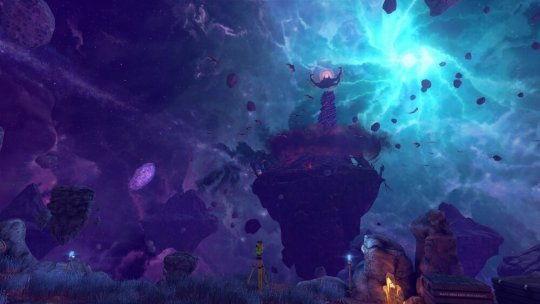
They not only got it right, but they also blew the whole damn thing out of the water. Black Mesa resets the bar for first-person shooters.
It has the benefit of being built on top of Valve’s solid foundation, while every facet has been shined to a modernized edge with improved physics, graphics, and more. Those first moments in Xen are simply awesome, and it was so well received that it’s been said even Valve, while researching during the development of their VR title, Half-Life: Alyx, Black Mesa’s version of Xen was referenced in favor of the original Half-Life.
Something I’ve always appreciated about Half Life’s level design, is that everything feels “lived in” and generally operates like you would expect as you explore offices, parking garages, maintenance areas, and more. Black Mesa raises that level of detail and soaks every environment with a density of atmosphere and memorable sequences spanning its 20 chapters.
The masterstroke that ties it all together is the superb direction, with spot on timing in its adrenaline-fueled crescendo moments, of which there are many. One in particular, in Black Mesa’s 12th chapter, “Surface Tension” features one of the coolest moments I’ve witnessed in a game—it’s a magical combination of these elements working in tandem with the game’s composition.
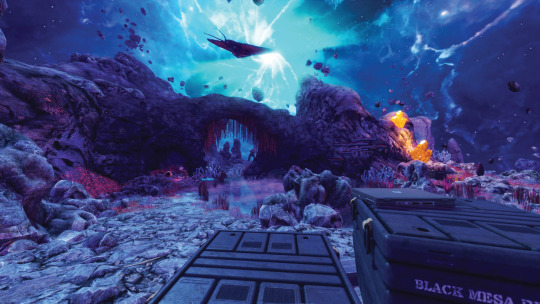
The credit for Black Mesa’s stellar soundtrack goes to Joel Nielsen. Give this man’s work a listen sometime on his YouTube page, JoelNielsenMusic, and I promise you’ll be impressed. Within Black Mesa, these tracks hit even harder with emotion, and are cued perfectly to the action on screen. It was convincing enough to relate with Gordon Freeman’s agency for his task and, frankly, I could’ve based my entire reasoning for choosing Black Mesa as my #1 game solely on its soundtrack.
But it would be a disservice to leave anything out. Black Mesa is a massive journey and one hell of a satisfying experience—and I could write pages and pages about it. But I’ll end here with this message.
To the modern first-person shooters, look here. To the Hollywood directors trying to translate video games to film, look here. To the future video game historians, remember Black Mesa.
4 notes
·
View notes
Text
GOTY 2021: #2 - Bioshock Infinite
This will be the second time I’ve written something about Bioshock Infinite this year, the first being a piece about a game living up to expectations—or not—after a very long wait to play it for yourself.
In my case, Bioshock Infinite was put on ice for eight years—in a trend that will sound familiar now if you’ve been keeping up with this list—because I didn’t have the equipment to match the specifications. I had somehow managed to avoid all spoilers during that time before I finally began the journey in May of this year. It obviously held up for me considering its position on my list, but I’d be lying if I said it got here just on its own merits.
Bioshock Infinite is a wild ride, both as a video game and as a product that was developed by a studio that was killed for it.
It was on my back burner years before I ever owned it, and my fascination for it didn’t end as the credits rolled. I was thinking about the implications of the plot, and I was thinking about Irrational Games, the beloved studio behind some of the most memorable and immersive games in video game history.
Immediately after Bioshock Infinite’s conclusion, I started reading the chapter on Irrational’s story found in Press Reset: Ruin and Recovery in the Video Game Industry, by author and journalist Jason Schreier. It’s an engrossing, but heartbreaking, tale that added an additional layer to Infinite—something that wasn’t possible at the time of its release. Schreier’s insights painted a clear picture into the origins of Infinite’s faults, both small and large. The most infamous at the time of release was the disparity between the final version in comparison to the various teases and demos prior. But having names and accounts made me appreciate what that team and its director, Ken Levine, accomplished in spite of the troubled development, including working under a company that wanted the unsustainable.
Irrational wanted to make an entertaining video game. To spin a compelling story with characters you could grow to like. To blow your mind with things only the powers of fiction—an element that video games thrive in—can provide. Did they do it? I think so, but I’m only one person and that’s truly for each person to decide.
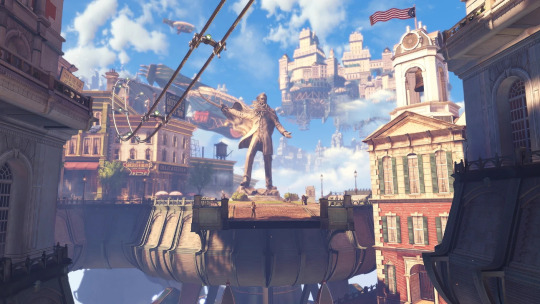
Bioshock Infinite has two identities.
It’s a first-person shooter with interesting weapons and stranger powers at your disposal to explore the city in the sky, Columbia, where protagonist, Booker Dewitt, is tasked by an unseen party to rescue Elizabeth, a mysterious woman capable of unimaginable things. One-part classic shooter, one-part unbroken narrative experience that video game movies attempt but fail by removing the player.
It’s a style of video game I’ve always enjoyed—with both good direction and execution, Infinite unfolds in front of you and asks, “how will you respond?” Regardless of limited choice, being the driver is far more engaging than as the passenger.
Simply put, I really liked Bioshock Infinite for a variety of reasons, and it was worth the nearly decade-long wait to see it for myself. The tragedy of Irrational Games didn’t make me like it less nor more, but it did compel me to remember it, and appreciate the people who lost their jobs to make it. Thank you all for the 19 hours of pure entertainment this year.
3 notes
·
View notes
Text
GOTY 2021: #3 - Monster Hunter Rise
Back in 2018 Capcom did the unthinkable and successfully broke through the largely insular fanbase of Monster Hunter—which was generally much more popular in Japan—with the launch of Monster Hunter World. Launching on both PS4 and Xbox One, Capcom sought the increase in power specifically to allow for major quality-of-life changes as part of an effort to open the door for the curious onlookers who found Monster Hunter’s gameplay loop overwhelming, to say the least. While Monster Hunter World is no less dense, it absolutely shed where necessary and was a groundbreaking event for the franchise as a whole.
You can imagine that, as someone who is a fan, it was a crushing moment personally when Capcom—understandably—skipped Nintendo’s platforms for World. At the time, I did not own either a PS4 or Xbox One, nor did I have a PC even close to capable of running it. But it turned out that Capcom hadn’t left us behind. World turned out to be a dual development, and a sister title, Monster Hunter Rise was coming up on its heels.
I’ll be honest, I was preordering Rise while the trailer was still rolling.

Monster Hunter Rise is like a “thank you for waiting” signed by Capcom to its Nintendo fanbase, as all of the lessons learned through World are present and accounted for. Both games share a similar brevity in its structure and in getting you to the fun. While it admittedly released unfinished—due to the ongoing pandemic wreaking havoc on development—Capcom quickly released their free 2.0 follow-up a month later.
For reference, the last Monster Hunter I played before Rise was Monster Hunter Generations for the Nintendo 3DS, so the shift in speed was impressive, to put it simply. Monster Hunter in the past was traditionally tedious—and I say that as a fan. Combat revolves around a stamina system, there are menus galore, and you wouldn’t have been out of place for having a wiki pulled up while playing. It’s not that any of this was bad, but it’s not hard to see why many would be put off by this, or simply overwhelmed by all of the information. Learning to master a weapon was equally intimidating from managing stamina to studying a monster’s attack patterns—even a weapon’s animation cycles!
Those coming from something such as an MMO would likely feel right at home, but to most this kind of gameplay is totally alien.
This is where Monster Hunter Rise succeeds, like World before it. Far more people are comfortable with a third-person action game, which is how Rise presents itself on the surface, and gives those players something to grab onto. While there’s still no shortage of information to dig into—and plenty of menus—it’s there when you want it, and only when you want it. You might be tempted to take in more than you need, but the line of quests designed for solo play will quickly get you up to speed without throwing on more than necessary. It’s a recurring theme for Rise that has won over even traditional fans who appreciate getting straight to the best parts.
It was that breakneck speed to the fun that ultimately pushed me to rate Monster Hunter Rise so highly. We play video games for entertainment—among other things—and when a game like this absolutely smashes that goal, it’s going to stand out from the rest.
If you’re a new player, I’d still recommend joining a friend if you can—whether you’re learning together or with a veteran—because Monster Hunter is no less unique even after streamlining much of the formula. If you feel it spark for you, however, you’ll be hard-pressed to find anything else like it on Nintendo Switch. Every facet has been shined to a gleam, with no lack of something to learn or new challenge to try.
If this new Monster Hunter is indeed here to stay, then we can look forward to more surprises like Rise.
4 notes
·
View notes
Text
GOTY 2021: #4 - Hyrule Warriors: Age of Calamity
I could sum this one up quickly by saying there’s a demo on the eShop, and it sold me in a heartbeat.
The demo launched a few weeks before the game’s release, allowing players to explore the first few missions in Omega Force’s second hybrid Legend of Zelda and Dynasty Warriors collaboration.
The first Hyrule Warriors, released in 2014 on the Wii U—before being ported to the Switch in 2018 combined the cast of Zelda’s major players into the tried-and-true chaotic action of the Dynasty Warriors franchise. Working together with Nintendo, Hyrule Warriors was bursting with familiar faces and locations that spanned from Ocarina of Time to Skyward Sword. It was a radical departure for Nintendo at the time, and somehow worked extremely well. So well, in fact, that many—including me—were ecstatic to find out last year that it wasn’t just a one-time deal.
This time, however, the setting was going to be tied directly to 2017’s The Legend of Zelda: Breath of the Wild, and initial teases implied the narrative would begin 100 years earlier—before Link’s time spent in stasis and the death of Princess Zelda’s champions.

It must be said that Dynasty Warriors is infamous in the video game scene.
I was only vaguely aware of Dynasty Warriors during the PS2 era, but that was all you really needed to know both sides. It is unapologetically simple to pick up—the combo system uses two buttons—but deceptively more complex than it appears on the surface. You’d be forgiven for not realizing that as for how many games there have been—and there have been a lot—the general makeup has been gradually iterative, from the graphics to the gameplay itself. Additionally, there’s always been criticism of quantity over quality hanging over it like dark cloud. The most current numbered title, Dynasty Warriors 9, released in 2018, but that’s not counting the two sub-series: Empires and Xtreme Legends—and yes, Dynasty Warriors 9 Empires is just around the corner. There are also two sister series, Samurai Warriors and Warriors Orochi.
All of this is to say that Dynasty Warriors has been around long enough to make both friends and enemies.
Why is this important? Because that’s arguably a lot of baggage to attach to another property, especially one revered as much as The Legend of Zelda. It raised eyebrows of some in 2014 and did so again when Hyrule Warriors: Age of Calamity was first announced in 2020. Even after following the first game’s success, the shadow from that cloud would return. Age of Calamity’s premise had a good hook, however, and was enticing to anyone who wanted to see more of the champions in their prime, rather than the small glimpses of their past seen in Breath of the Wild.
Hyrule Warriors had already inspired me to become a Dynasty Warriors fan, so when that demo hit the eShop I was already on board to see what Omega Force and Nintendo had done to follow up their first effort. My first impressions told me to delete the demo now after playing the first level—I was sold.
If I could describe Age of Calamity only one way, I would call it the spiritual successor to Nintendo’s experimental Zelda II: The Adventure of Link. With Nintendo’s assistance, the game lifts Breath of the Wild’s assets wholesale in the best of ways—the UI, the map, the characters, the locations, the materials, the recipes, it’s all here. Playing Age of Calamity is almost like playing Breath of the Wild—familiar, but different. Just like Zelda II turned Hyrule on its side, Age of Calamity is the souped-up cousin of Breath of the Wild, where weapons don’t break, and Princess Zelda doesn’t need anyone to save her. The heightened action fits extremely well as Hyrule is bracing for the coming impact of Calamity Ganon.
When the game officially released and it was actually in my hands, you couldn’t tear me away from it. I could write several detailed paragraphs on both the mechanics and story—the narrative deployed a few unexpected, fun twists—but a game like this ultimately must speak for itself. I can’t tell you if you’re going to like Dynasty Warriors, but I will say that Age of Calamity is Omega Force’s franchise in absolute top form.
3 notes
·
View notes
Text
GOTY 2021: #5 - The Great Ace Attorney Chronicles
While I’ve always been aware of Capcom’s famous ace attorney, Phoenix Wright, and had a general knowledge of the gameplay found in the now 10-year-old franchise, they were something I appreciated more so at a distance during the Nintendo DS era. Like most people, I have genres that I prefer, some that I have little exposure with, and others that I’ve skipped entirely for one reason or another.
It’s funny to think about in hindsight, though.
I’ve always enjoyed both reading and puzzles—the target audience for Ace Attorney. For whatever reason, however, those interests didn’t always translate to video games. Give me something like Paper Mario, and I was all in. The visual novel genre was another beast entirely, and for a lack of a better explanation, they just didn’t mesh with someone like me who preferred being able to take action.
But back in Spring of this year, after Capcom announced the localized collection of The Great Ace Attorney Chronicles—packaging both games formally exclusive to Japan—I decided to take a chance at something new and preordered it.
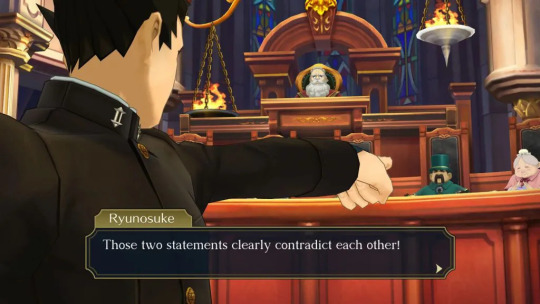
Set during Meiji-era Japan, several decades before the modern-day courtroom setting of Phoenix Wright, Chronicles stars his ancestor, Naruhodo Ryunosuke, an academy student that is thrust into the world of law when he’s unexpectedly forced to defend his own innocence from accusations of murder.
The Great Ace Attorney Chronicles spans two games with five episodes each. Every episode revolves around a unique case while also adding to the overarching story of both Ryunosuke and his assistant, Susato Mikotoba.
The core gameplay requires a lot of reading—if you’re someone who enjoys a good narrative, you’ll absolutely find it here. If you prefer to skip through dialog quickly to get back into the action, however, this series may not be for you. In between the longer conversations you’ll explore crime scenes, and most importantly, look for the truth as the drama within the courtroom develops. It’s a fairly linear experience—to the point where a “reader” mode can be enabled to allow the game to solve the puzzles for you while simply enjoying the story. Personally, I enjoyed the puzzles as they generally revolve around an attention to detail, whether it’s a piece of evidence or a callback to a prior conversation.
At the time of writing this, I’ve only played through the first game, Adventures, but I’m looking forward to returning to it next year for the second act. If the first game is any indication, then I expect more good times with this one in the future.
I can’t close this one out yet before mentioning what was easily my favorite aspect in The Great Ace Attorney, and that is the characters of Herlock Sholmes and Iris Wilson. In the original Japanese release, Sir Arthur Conan Doyle’s famous detective featured as a part of the main cast with a Capcom-flavored twist that gave both a Steampunk-like aesthetic. For legal reasons, Holmes and Watson are renamed in the international releases, but fear not, as there is no lack for references within their depictions from nods to Doyle’s short stories to the well-known residence of 221B Baker Street. The inclusion of Holmes since inspired me to start a trek through all of Doyle’s Sherlock fiction this year, which I read alongside playing the game.
That’s what I think makes video games great; we tend to pick up new hobbies or interests that, in a way, blur the lines between the world of the game and our own. The Great Ace Attorney Chronicles is worth the admission on its own merit, but it climbed this high on my list for simply being inspiring.
It’s one thing when the game leaves an impression on you, but when those impressions jump out the world and seep into yours, it becomes that much more lasting.
7 notes
·
View notes
Text
GOTY 2021: #6 - Mario Party Superstars
It was clear that Mario Party Superstars was going to be something really special when the opening cinematic revealed a warmly familiar setting that felt like it was winking not just at me, but at everyone else that grew up playing Nintendo’s Mario-themed take on the family board game.
I’ve played and owned just about every game in this series that’s spanned many years as well as several console generations. If you’re unfamiliar with its history, Mario Party went through something of a transformation by the time of Mario Party 9 for the Nintendo Wii. Following the merging of Hudson Soft—former developers of Mario Party—with its parent company, the formula was showing signs of finding a new identity with NDcube carrying on with the party. Each entry since then, whether on console or handheld, altered the formula in ways that made Mario Party feel both familiar and different at the same time. These changes didn’t please everyone—common complaints were the changes to the flow of the gameplay, such as having every player move together on the board.
But by 2018, with the release of Super Mario Party, NDcube seemed to became more confident in their design, winning more fans over. While it wasn’t perfect, in hindsight, it laid the groundwork for NDcube’s biggest hit yet.

I think what makes Mario Party Superstars succeed is that it has a double identity—the old fans feel appreciated, and the newcomers get to experience the best version of what those same fans remember so fondly. While the collection of boards is admittedly small—and hopefully will be addressed in the near future—those present have been lovingly crafted in high definition and function largely similar to their original forms. The efforts in presentation go well beyond the boards, too.
A plentiful smattering of fan-favorite minigames have also been restored, no less stunning visually. Even the animations are fun; characters will snicker at each other when someone triggers their well-laid trap, and push one another out of the way as they dash around the board.
Nostalgia is the key word here.
Playing Mario Party Superstars with someone who missed out is like a rare opportunity for that person to see it as you saw it. If there’s one thing I enjoy most about video games, it’s sharing a past experience, whether as it was or in a modern day package. While NDcube was clearly targeting people like me, they also cleverly extended an invitation to a new generation looking to see what the madness is all about. Simply put, Mario Party doesn’t get much better than this latest entry, and should be the bar to aim for moving forward.
4 notes
·
View notes
Text
GOTY 2021: #7 - Metroid Dread
My history with Metroid is pretty spotty compared to most of Nintendo’s other franchises, both 2D and 3D—I completely skipped the 2D era altogether.
The first steps into this beloved franchise I took were with the Metroid Prime series. I eventually put time into all three games, but because I never owned any of them it was limited—a few hours each. Regardless, somewhere else in between, I received Metroid Prime Hunters for the Nintendo DS after enjoying the included demo. Sadly, I failed to finish that, too.
Looking back at Metroid’s inability to grab a hold of me, I can see how much my tastes in video games have changed. A couple of years ago, however, I started writing down games I had finished into a list for the entire year, and it inspired me to try new things as well as go back to the ones I let go—like Metroid.
Because of this, the first Metroid game I completed was Super Metroid through Nintendo’s online service and it was so convincing that I continued to make up for the past and played through the entirety of Metroid Prime Hunters. I also managed to grab copies of Metroid Prime 1, 2 and 3 a few years ago before they skyrocketed in price. They’re still in progress, admittedly, but in striking while the iron was hot, I played through Metroid Fusion, adding it to my growing history.
Though my experience with Metroid is still full of holes in 2021, I understood enough to know why the reveal of Metroid Dread was such a big deal this past Summer. From the teases to the years-long gap in a new 2D Metroid—Samus Returns aside—it wasn’t hard to be swept up in it. For those reasons, Metroid Dread was one of a handful of games I preordered this year, no questions asked, following that initial announcement.
I’ve since learned two things after having played it: it was a good choice and I’m really bad at Metroid games.

I guess I shouldn’t feel that way, though, because the internet seems to agree with me: Metroid Dread is cutthroat when it wants to be—but it doesn’t always want to be. That’s probably why I enjoyed it so much. I often had the freedom to explore my surroundings, adjust myself to newly obtained abilities, and scavenge for secrets that were previously out of reach. Not unheard of for this genre Metroid helped to create, of course.
Then there were the moments that Dread awakens you rudely, reminding you of the stakes.
The ominous E.M.M.I., teased in the initial reveal, are one of the toughest threats Samus must contend with while exploring ZDR. These robotic fiends function like gatekeepers, questioning if you’re really ready to move on. Some were notoriously frustrating—for some they were cause enough to quit Metroid Dread altogether. That kind of challenge is welcomed by some, but there’s no question that this game can reach in and crush your soul like a can. “Why do we continue in a game like this?”, I asked myself more than once. I can’t speak for everyone, but what can be said about Metroid Dread is that the level design is such that it doesn’t set you up for failure, especially when approaching a major boss.
But more than that, it’s when you do overcome that boss and a new ability is granted. Samus becomes much more powerful after each one—by the end of the game it almost feels like cheating! Those moments are an empowering reward and the motivation that fueled me to push forward.
Now, it must be said that Metroid Dread has a lot to offer besides a high difficulty—great controls, atmosphere, sound design—all wrapped in the usual Nintendo certified polish. Those features alone are worth awarding, but I think I’ll remember it most for keeping me sharp, as someone who’s been doing this for a long time now. The difficulty won’t be for everyone, and don’t feel ashamed for it. Dig deep enough though, and you’ll find that Metroid Dread truly wants you to get to the end, and it’ll be there to slap you on the back for every milestone you make.
4 notes
·
View notes
Text
GOTY 2021: #8 - Sherlock Holmes: Crimes and Punishments
It was the abnormal case of the Kew Gardens Drama.
Developer Frogware’s love letter to Holmes fans had already won me over, but it was this particular case that had me exhausting every mechanic within the game and fighting my indecisiveness to the very end. I had studied the evidence, scrutinized the witness testimony, and considered all motives carefully. I had this one, I thought to myself, and locked in my choice.
But the person I suspected was in fact not guilty, I discovered later, and I had been fooled into believing in the wrong person.
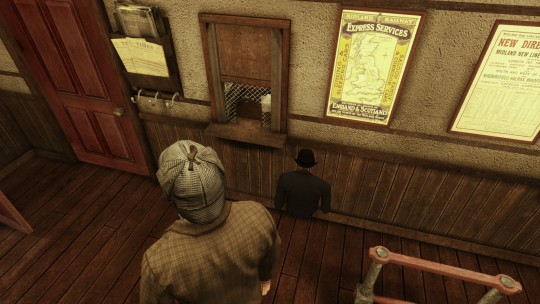
These difficult choices are one of Crimes and Punishments neatest features. The person you pin the crime on, and the thought process you follow to get there, are both up to you. All evidence and motives are discovered through exploration of the crime scenes and dialogs with witnesses and suspects. These interactions are played through the eyes of the famous detective himself, while his trusted colleague, Dr. John Watson, tags along and assists his good friend. Collected information can be reviewed in your notes, and as you begin to build a picture of what has happened, these pieces are displayed in a gradually expanding tree—a visual nod that simulates Holmes’ method of deduction.
These links in the chain can be moved around on a whim as your own suspicions—as well as new discoveries—develop throughout the case.
Compounding your involvement further, the method of apprehension is for you to decide. Should you round up Lestrade and the rest of Scotland Yard to arrest them as criminals to serve a life in prison? Or judge their character as flawed, but redeemable, and allow them the chance to rebuild a new life?
All of this is made even better for the fact that the developers cleverly hide the truth by default.
At the conclusion of one of Crimes and Punishments six cases, you can choose to confirm your accuracy with the press of a button—it’s entirely possible to miss clues and condemn the wrong person. This was a personal highlight for me, and I decided early on to wait until the end of the game to check all my results. I felt that not knowing was a unique rush to Crimes and Punishments and made my choices more special—something I really had to own.
So, after a thorough investigation that included unmasking the double lives of the Kew Gardens staff, the mysterious murder of Montague Dunne—the director of the distinguished exhibit—twisted into a complex plot to end one man’s life under devious methods that were astonishingly creative. I started reading Sir Arthur Conan Doyle’s classic short stories this year, and I can say confidently that of the six available cases, this one rang so true to the most absurd plots Sherlock Holmes routinely seeks out.
Crimes and Punishments wasn’t finished with me after discovering the culprit, however, and tasked me further to uncover a new truth: they hadn’t acted alone.
After considering all the possibilities, I made my choice and breathed a final sigh. Feeling confident, I started the next case, but when I read the letter waiting for me back at 221B Baker Street—a recurring event at the start of each case—it seemed that the real accomplice had had the last laugh, subtly implying that they had gotten away with it.
That experience is what I appreciated most about Crimes and Punishments. I wasn’t forced to start over, nor punished in any way for making the wrong choice. I like to think Frogwares recognized that it’s simply bound to happen in detective work, and a video game should allow for those mistakes, rather than restrict it to a win or lose scenario. The other games on this list are no less for not doing so, but it certainly set this one apart.
8 notes
·
View notes